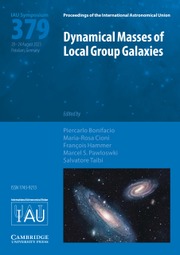No CrossRef data available.
Article contents
Survey of Planetary Nebulae in the Andromeda galaxy (M 31)
Published online by Cambridge University Press: 06 October 2025
Abstract
We summarize the main results from the survey of Planetary Nebulae (PNe) in M 31 with Megacam@CFHT and subsequent spectroscopy with Hectospec@MMT. We identified ∼5000 PNe in M 31 (∼1200 with spectroscopy; ∼200 with chemical abundances). We find a PN Luminosity Function faint-end rise, linked to a percentage of older stars in the parent population. We utilize PN extinction to distinguish young and old PNe. We find that the [Ar/H] vs [O/Ar] plane for emission-line nebulae is analogous to the [Fe/H] vs [α/Fe] plane for stars, and exploration of the M 31 disc PNe in this plane allowed us to constrain its chemical enrichment history. We find the kinematically and chemically distinct thin and thick discs of M 31, and that the G1-clump substructure is formed from perturbed disc material. We infer that M 31 has had a wet major (mass-ratio∼1:5) merger ∼2.5-4 Gyr ago, and obtain important constraints on the cannibalized satellite properties.
Keywords
Information
- Type
- Contributed Paper
- Information
- Copyright
- © The Author(s), 2025. Published by Cambridge University Press on behalf of International Astronomical Union


